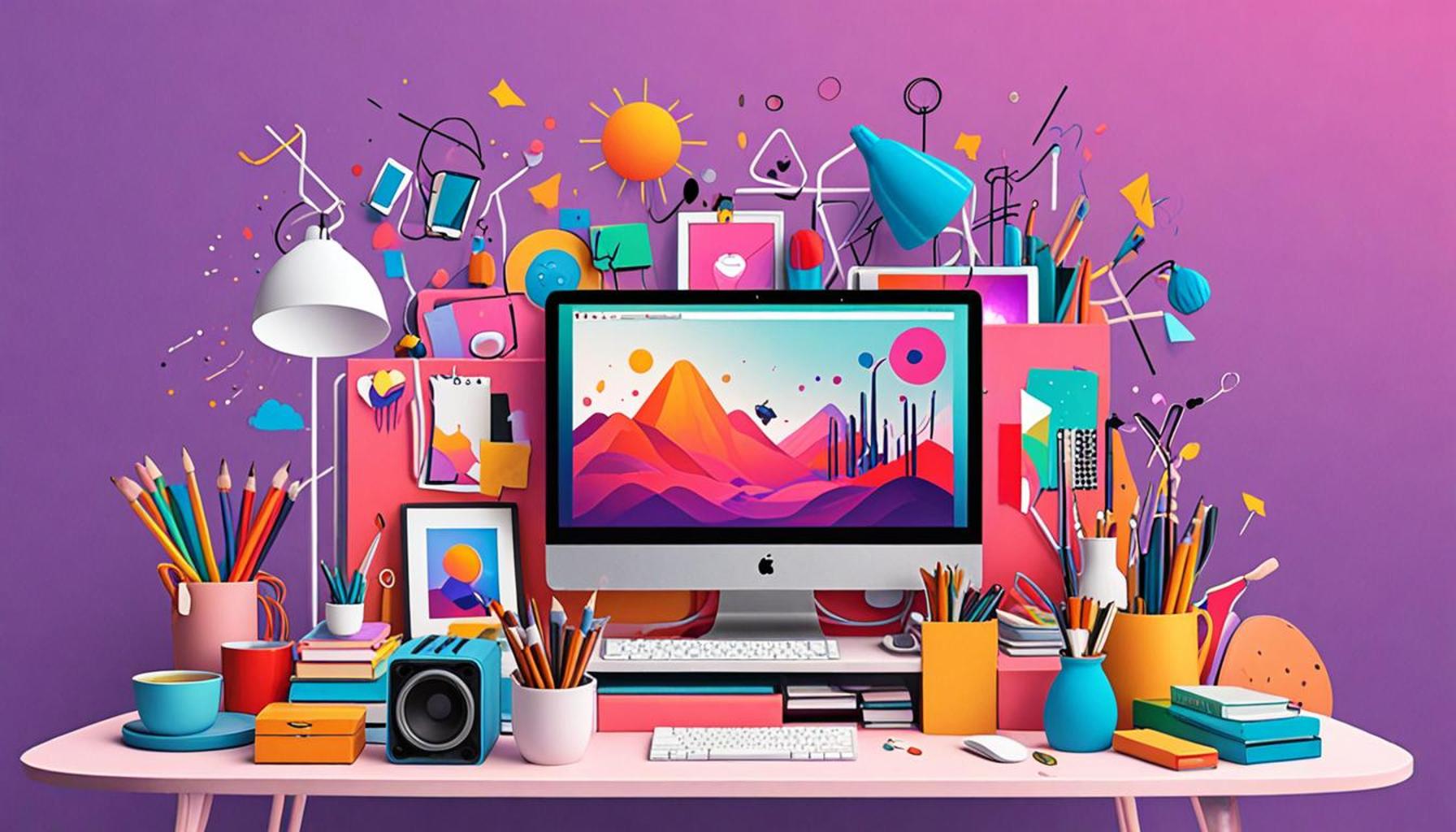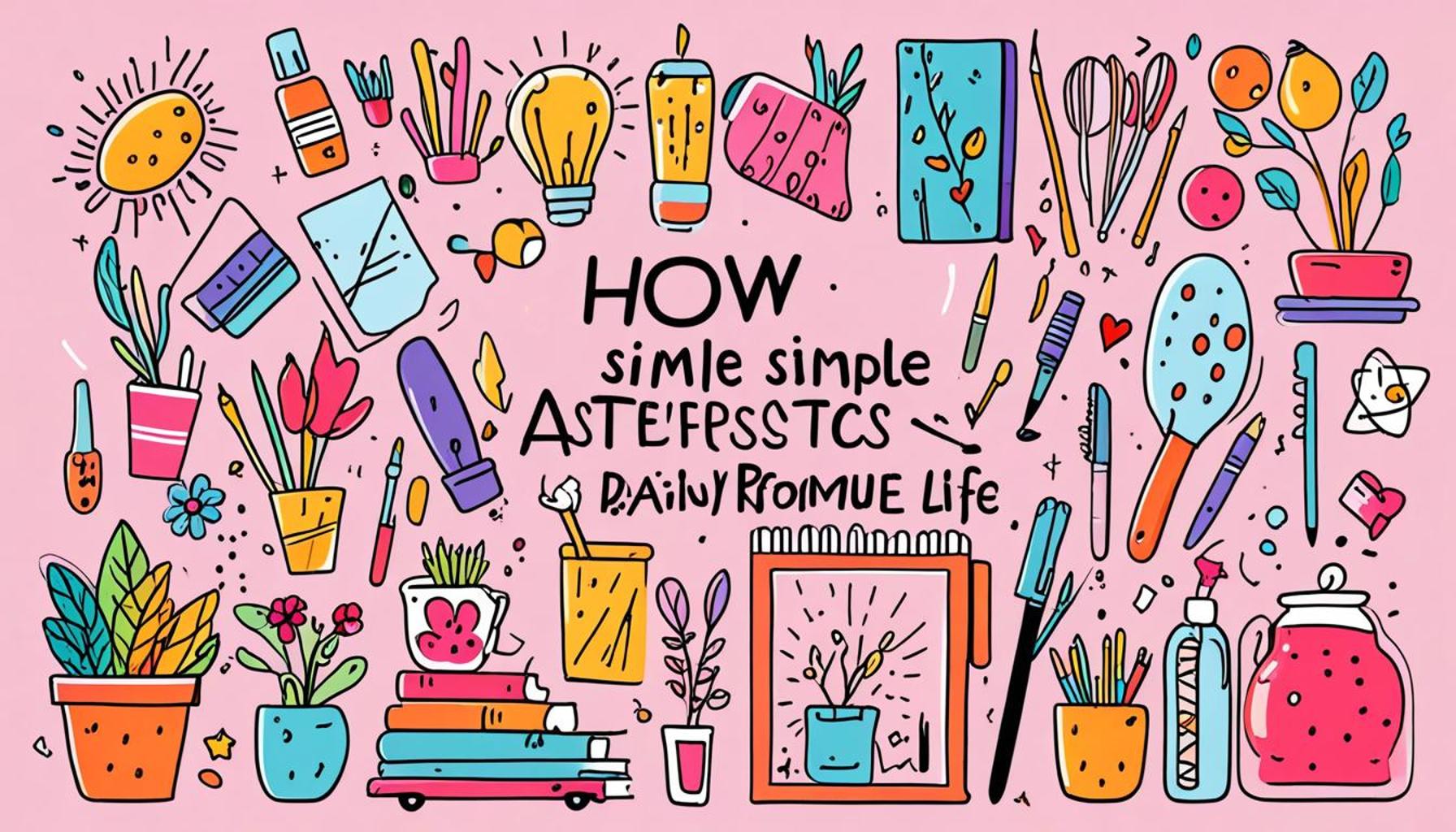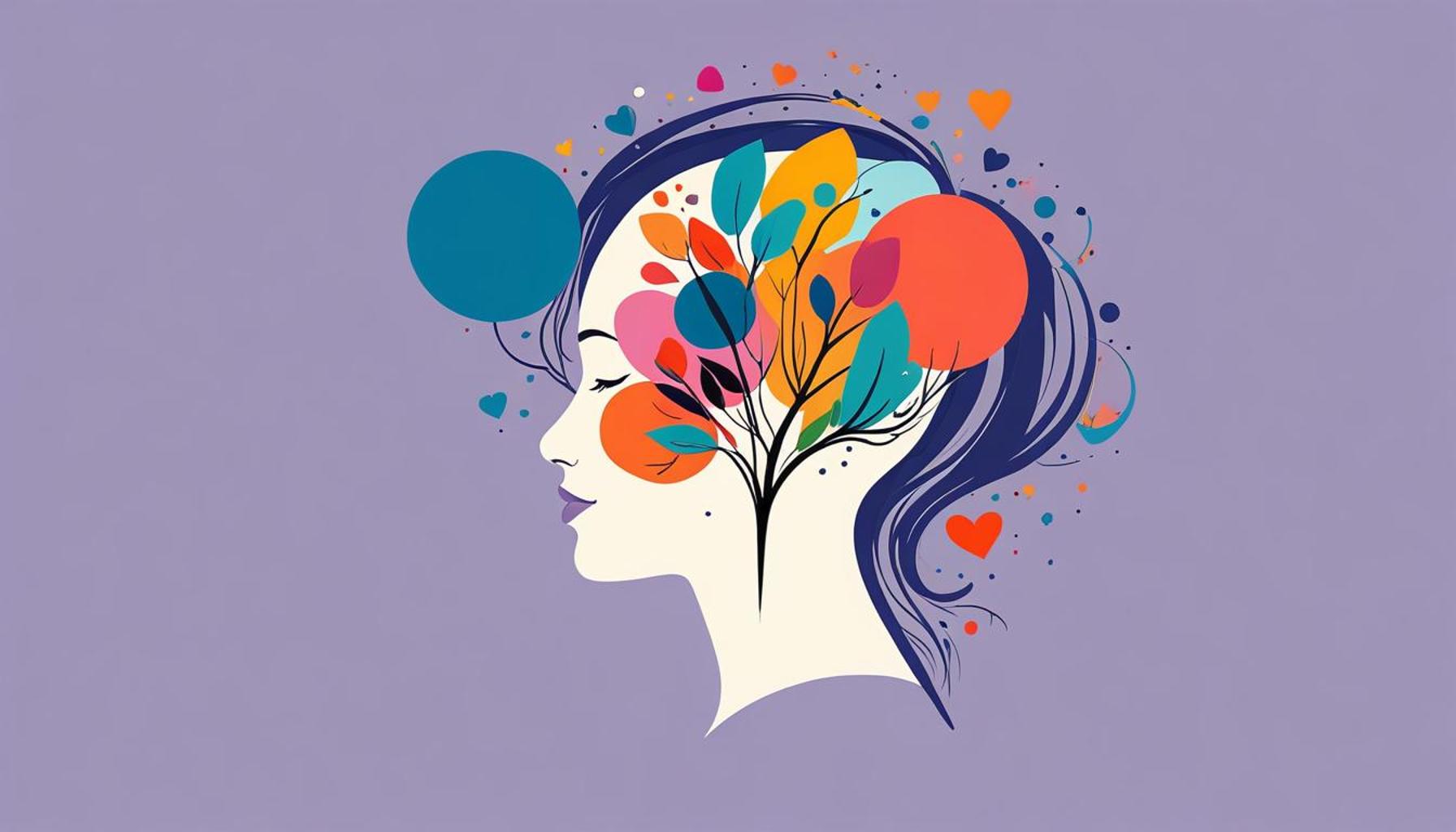The Importance of Simple Aesthetics in Digital Life: Organizing Your Virtual Space

Creating a Serene Digital Environment
With the surge of technology in everyday life, the virtual aspects of our existence can often become chaotic. Email notifications ping incessantly, social media updates seem to flood in at every turn, and an endless array of browser tabs can lead to a disorganized digital workspace. This modern digital clutter can culminate in heightened stress levels and a diminished sense of control. To combat this, focusing on simple aesthetics in our digital environments is becoming more crucial than ever.
A carefully curated virtual space not only fosters productivity but also enhances mental clarity. For instance, studies show that environments with fewer distractions allow individuals to work more effectively. Here are some key benefits of embracing minimalism in your digital life:
- Enhanced Focus: Research suggests that a clean and organized digital interface can markedly reduce distractions that may lead to procrastination. By limiting the number of open applications and notifications, you create a distraction-free zone that supports deeper concentration on tasks at hand.
- Time Efficiency: Streamlined navigation is invaluable in today’s fast-paced environment. By implementing simple file organization systems, such as clearly labeled folders and the reduction of unnecessary files, you can significantly cut down the time spent searching for important documents. Even simple techniques like bookmarking frequently visited websites can save valuable minutes throughout your workday.
- Better User Experience: Minimalistic designs not only look appealing but are easier to navigate. For instance, platforms like Google are renowned for their simple interfaces, which enhance user engagement. Users often find intuitive layouts more pleasurable, leading to a better overall experience.
This trend towards minimalism is not merely a fleeting phase; it is increasingly recognized as a necessity for maintaining a functional and enjoyable online experience. Just as a decluttered living space can improve your mood and wellbeing, so too can a decluttered digital existence lead to reductions in anxiety and increased efficiency. Techniques such as digital decluttering—removing outdated apps, unsubscribing from unwanted email lists, or even designating specific times to check social media—can radically transform how we interact with our digital tools.
By taking the first steps to simplify your digital life, you are not just creating a space that looks good; you are paving the way for a more organized mind and a productive lifestyle. As you embark on this journey, consider evaluating how much time you spend online and how you can reshape that environment to reflect a calmer and more purposeful approach to technology.
DISCOVER MORE: Click here to learn about conscious consumption and decluttering

The Benefits of Digital Minimalism
Embracing digital minimalism can have profound effects on both your productivity and mental well-being. In today’s hyper-connected society, it’s essential to distinguish between the digital noise that surrounds us and the meaningful interactions we intend to foster. By decluttering your virtual space, not only do you create an aesthetically pleasing environment, but you also cultivate a sanctuary that promotes creativity and focus.
One of the core tenets of minimalism is to consciously choose what remains in your digital space. This could include the following strategies:
- Streamlined Apps: Assess the applications on your devices and identify those that truly serve a purpose. Combing through apps that clutter your screens can offer immediate clarity. For example, deleting unused apps can not only declutter your home screen but also reduce the number of notifications that vie for your attention.
- Task Prioritization: Using productivity methods, such as the Eisenhower Matrix, can be highly beneficial. This approach helps in categorizing tasks based on urgency and importance, ensuring that your digital to-do lists reflect your current priorities rather than a sinking pile of responsibilities.
- Visual Harmony: Customizing your digital background or theme can significantly influence your mood. Opting for calming colors and minimal designs can create a workspace that feels inviting and less overwhelming, allowing you to settle into tasks more comfortably. Consider using wallpapers that evoke a sense of tranquility, such as landscapes or abstract art.
- Regular Maintenance: Just as a physical space requires consistent upkeep, your digital realm also demands regular attention. Schedule a weekly or monthly “digital detox,” during which you review and clean up files, unsubscribe from unnecessary services, and delete outdated information from your platforms.
Moreover, when we establish a serene environment, it not only paves the way for enhanced productivity but also positively influences our mental health. A well-organized digital space reduces anxiety, allowing users to engage more freely with their tasks without the weight of disorder looming over them. According to a report by the American Psychological Association, clutter in any form can lead to feelings of stress and a lack of control. Therefore, making the effort to curate a simpler digital aesthetic becomes not just a matter of preference but a necessity for maintaining well-being.
Understanding the importance of simple aesthetics in digital spaces can redefine how we interact with technology. It empowers users to take control of their online experiences, aligning them more closely with personal goals and aspirations. As we navigate through a digital landscape laden with distractions, finding balance becomes paramount. By implementing these strategies, you can cultivate a digital environment that inspires rather than overwhelms, making every interaction count.
The Importance of Simple Aesthetics in Digital Life: Organizing Your Virtual Space
In the modern, fast-paced digital landscape, simple aesthetics play a crucial role in enhancing user experience. The desire for clarity and ease of navigation has become paramount. When users encounter a well-organized virtual space, they are more likely to engage with the content, making it essential for website designers and digital content creators to prioritize simplicity.The principles of minimalism dictate that less is often more. By reducing clutter and focusing on essential elements, users can locate the information they need quickly. This streamlined approach not only improves user satisfaction but also fosters a sense of calm in what can often feel like an overwhelming digital environment.Moreover, simple aesthetics can lead to increased accessibility. By employing straightforward design features, individuals with varying levels of tech-savviness can navigate digital spaces efficiently. This inclusivity paves the way for a broader audience and creates an environment where information is accessible to all.A well-organized digital space also enhances productivity. When workspaces are uncluttered and visually appealing, users can focus on the tasks at hand without the distractions that come from visual noise. This can lead to a more engaged and productive user experience, ultimately reflecting positively on the effectiveness of digital platforms.To illustrate the profound influence of simple aesthetics, consider the impact of color schemes and typography. Thoughtfully chosen colors that evoke certain emotions can significantly alter the perception of a brand or concept. Similarly, easy-to-read typography can enhance understanding and retention of information, making it imperative for digital creators to select these elements judiciously.Thus, as we navigate through our increasingly digital lives, the significance of simple aesthetics and organized virtual spaces cannot be overstated. Prioritizing these elements not only benefits users but also elevates the integrity of the digital content we consume.
| Category | Benefits |
|---|---|
| User Engagement | A clean interface draws users in, fostering interaction and exploration. |
| Accessibility | Simplified designs remove barriers, ensuring all users can easily navigate and understand. |
As we embrace digital transformation, understanding and implementing the importance of aesthetic simplicity can lead to profound improvements in how we interact with technology, making our digital experience not only productive but meaningful.
DISCOVER MORE: Click here to uncover insights</p
Creating Intuitive Navigation for Enhanced Efficiency
In addition to the visual appeal of a decluttered virtual space, intuitive navigation plays a crucial role in enhancing productivity. The way we organize our digital assets directly influences how quickly and effectively we can access what we need. Thoughtful design doesn’t just stop at aesthetics; it offers a seamless experience that allows users to navigate their digital lives effortlessly.
One strategy to improve navigation is through the implementation of folders and tagging systems. Organizing documents and files into designated folders can drastically reduce the time spent searching for essential materials. For instance, creating categorized folders such as “Work,” “Personal,” and “Projects” can help streamline the discovery process. Using tags within these folders allows for a multifaceted approach to organization—files can be located by theme, date, or relevance, promoting a more efficient workflow.
Furthermore, utilizing cloud storage solutions can enhance accessibility while maintaining a clean interface. Platforms like Google Drive or Dropbox provide not only storage space but also tools for collaboration. The key is to maintain a logical hierarchy, ensuring that files are easy to locate, which significantly reduces the time spent navigating chaotic digital environments. With cloud services, it also becomes feasible to access your files from anywhere, providing flexibility that enhances productivity.
The Role of Consistency in Aesthetic Choices
Consistency in design is vital when it comes to creating an aesthetically pleasing digital space. The harmonious use of colors, fonts, and icons across your devices can create a sense of familiarity and comfort. Studies show that this approach can increase cognitive ease, meaning users are less mentally taxed by their environment, thus focusing more on tasks at hand. This idea is echoed in the principles of user interface design, where consistency improves usability and enhances the overall user experience.
Additionally, consider employing design frameworks such as visual hierarchy when arranging your virtual space. For example, prioritize the placement of vital tools on your desktop or, within apps, so that they are immediately visible. A well-organized main screen with controls or shortcuts arranged in order of usage serves not only to declutter but also to make your digital space functional and user-friendly.
The Psychological Impact of Visual Clarity
Visual clarity transcends mere aesthetics; it reflects a direct connection between your digital environment and mental clarity. Research in environmental psychology emphasizes that clean, organized spaces—both physical and digital—lead to improved focus and reduced stress levels. A space laden with excessive notifications and clutter can trigger feelings of anxiety, making it harder to concentrate or complete genuine tasks effectively.
As you commit to improving your digital aesthetics, it’s important to recognize that this practice is not just about creating a beautiful interface; it’s about fostering a healthy relationship with technology. Incorporating regular reviews of your digital footprint—akin to spring cleaning—promotes a habit of discernment about what truly adds value to your life.
By embracing these principles and strategies, you can effectively transform your digital life into a space that aligns with your personal and professional goals, facilitating not just organization and efficiency, but overall satisfaction in your digital interactions. This intentional approach empowers users to redefine their virtual spaces, ultimately establishing stronger connections with their digital lives.
DISCOVER MORE: Click here to delve into the art of simplicity in photography
Conclusion
In an age where our digital lives intertwine seamlessly with our daily routines, the significance of simple aesthetics in organizing our virtual spaces cannot be overstated. As we have discussed, a clean and well-organized digital environment enhances not only our productivity but also our mental clarity and emotional well-being. By employing intuitive navigation systems, utilizing cloud storage, and fostering design consistency, we can create virtual spaces that not only look appealing but also function efficiently.
The journey to an aesthetically pleasing digital environment begins with a commitment to declutter and prioritize what truly matters. By regularly assessing our digital footprint and implementing strategies such as folders and tagging, we can cultivate a workflow that feels streamlined and manageable. Importantly, this practice is not just an exercise in aesthetics; it empowers us to reclaim our focus amidst the chaos of notifications and distractions that pervade modern technology.
Ultimately, investing time and effort into organizing our digital lives is a step towards achieving greater satisfaction and connection in our interactions with technology. Simple aesthetics foster productive environments that resonate with our personal and professional aspirations. As we embrace these principles, we can transform our virtual spaces into havens of clarity, efficiency, and creativity—enabling us to thrive in an increasingly complex digital world.


